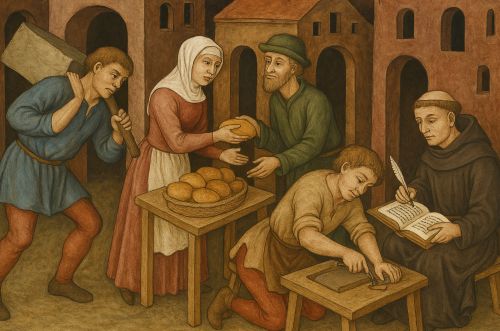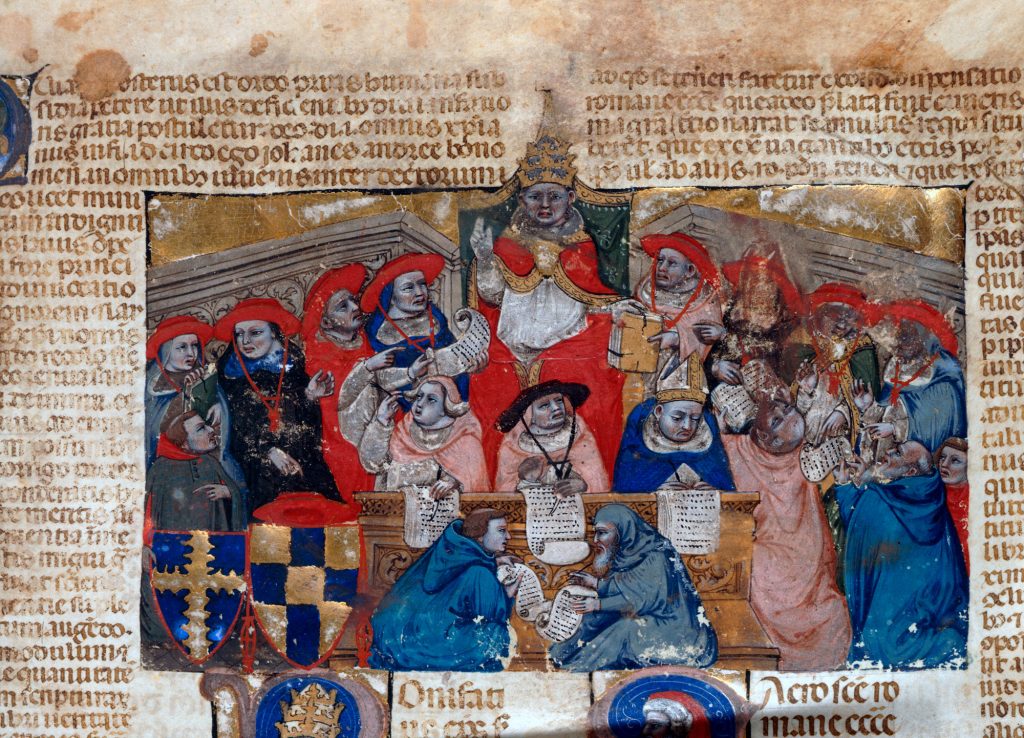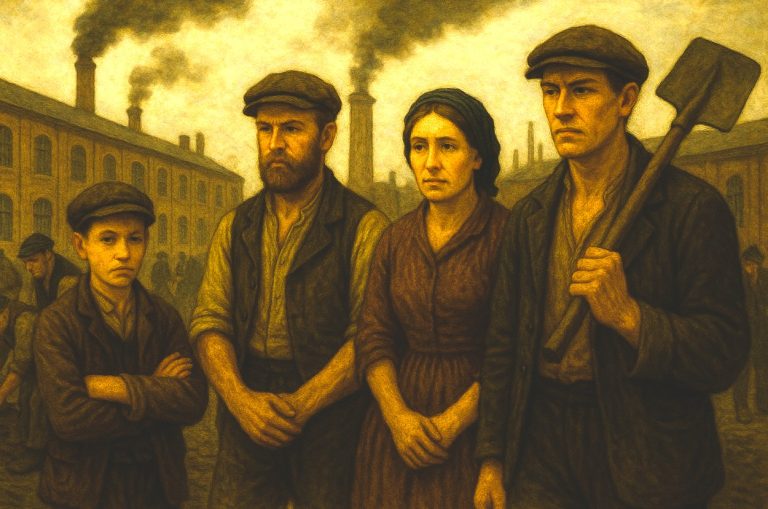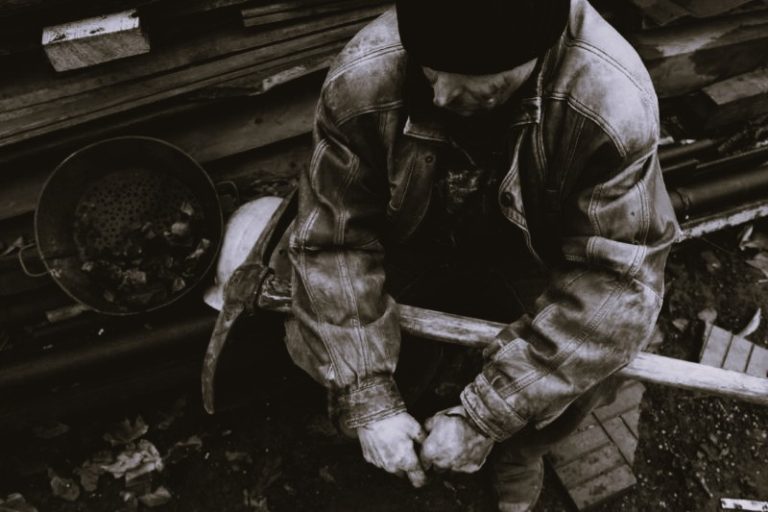

The medieval economy, often portrayed as rigid and hierarchical, in fact operated through a mosaic of temporary, negotiated, and adaptive forms of labor.

By Matthew A. McIntosh
Public Historian
Brewminate
Introduction
When modern commentators speak of the “gig economy,” they describe a world of temporary contracts, freelance arrangements, and project-based labor replacing long-term employment. Yet long before the rise of app-based work, similar dynamics shaped the medieval European economy. Beneath the fixed hierarchies of manor, guild, and Church, countless men and women survived by assembling a patchwork of short-term, irregular, and supplemental jobs. Priests performed multiple functions to sustain underfunded parishes, artisans hired themselves out by the day or by the piece, and rural laborers moved from estate to estate as seasonal demand shifted. The medieval economy, often imagined as static and hierarchical, was in practice far more fluid and transactional.
What follows examines that fluidity through three spheres of life where it was most visible: the ecclesiastical world of the parish clergy, the independent crafts and mercantile trades of urban centers, and the shifting, seasonal workforce of the countryside. These domains reveal a system in which livelihoods depended less on permanent appointments than on a series of negotiated engagements. Surviving evidence from manorial records, wage rolls, and ecclesiastical accounts shows that many medieval workers, including those within the Church itself , operated under conditions strikingly similar to modern forms of casual employment.1
The purpose of this study is not to impose an anachronistic framework upon the past, but to use the modern concept of “gig work” as an interpretive lens through which to reconsider the flexibility, insecurity, and ingenuity of medieval labor. By tracing how clerics, craftspeople, and peasants balanced multiple forms of income, I argue that what we now call the gig economy was, in different terms, part of everyday survival in medieval Europe. The comparison highlights both continuity and contrast: while the institutional and legal structures were profoundly different, the underlying human negotiation between stability and necessity remains recognizably the same.
The Church, Benefices, and the Patchwork Livelihood of Parish Clergy

The medieval Church was one of Europe’s largest employers, but its internal economy was anything but uniform. While bishops, abbots, and cathedral canons enjoyed stable benefices and secure stipends, the average parish priest often occupied the lower rungs of this vast hierarchy. His income depended not on a fixed salary but on an unstable combination of tithes, fees, and local donations.2 The system of ecclesiastical benefices, developed to fund religious offices through land and tithe endowments, frequently left the lesser clergy in precarious conditions. Vicars serving appropriated parishes, where the tithes were claimed by monasteries or cathedral chapters, were typically granted only a fraction of the revenues their offices generated.3
To supplement this meager income, many parish priests engaged in what might today be called “side work.” Teaching local children, providing legal or notarial services, managing small plots of farmland, or serving as chaplains to wealthy patrons were all ways to patch together a living.4 Surviving diocesan visitation records from England and France note frequent complaints about absenteeism, moonlighting, and pluralism, symptoms of a system that encouraged priests to diversify their income rather than rely on a single benefice.5 In some regions, especially in rural areas where tithes were sparse, priests even took up agricultural labor alongside their parish duties, blurring the line between clerical and lay economies.
The institutional structure of the Church both sustained and constrained this informal economy. The sale and leasing of benefices, a practice the papacy condemned as simony, reflected the commodification of spiritual office.6 The chantry system, in which wealthy patrons endowed private masses for the dead, also generated short-term employment for clerics hired to perform daily prayers or memorial services. These arrangements, contractual in nature and limited in duration, closely resemble project-based work in modern terms.7
This patchwork pattern of livelihood reveals a clerical underclass that depended on multiple, irregular sources of income. The stability of Church hierarchy masked an economy of precarious labor beneath it, one that required adaptability and entrepreneurial effort. Parish priests in late medieval Europe were thus early participants in a kind of “holy gig economy,” compelled to balance vocation and subsistence in a system that rewarded flexibility over permanence.
Crafts, Merchants, and Temporary Engagements in the Urban and Rural Economy

The medieval city was a landscape of constant negotiation between independence and regulation. Guilds and charters established hierarchies of master, journeyman, and apprentice, yet within and beyond those boundaries existed a large population of casual workers and independent producers. Day laborers, hired craftsmen, and itinerant artisans all found themselves working on a project basis, earning wages for specific commissions rather than holding lifelong posts.8 The urban building trades illustrate this clearly. Masons, carpenters, and glaziers were often contracted for the duration of a single construction project (cathedral phases, civic walls, or guildhalls) after which they had to seek their next engagement.9
Such employment systems reflected both opportunity and instability. In prosperous towns like London, Florence, or Bruges, the expansion of civic and ecclesiastical building projects created intermittent demand for skilled labor. Artisans frequently traveled between cities to follow the availability of work, forming networks of mobile expertise.10 The same mobility characterized textile workers and metal artisans. In England’s East Anglia, for example, cloth finishers and dyers were hired by the piece rather than by fixed tenure, producing a fluid labor market that blurred the distinction between free artisans and dependent wage earners.11 These tradespeople operated much like modern freelancers, self-employed in theory, but reliant on a constant flow of commissions to survive.
Merchants, too, embodied the essence of economic flexibility. While the great trading families maintained stable enterprises, the majority of sellers who populated fairs and marketplaces were small-scale dealers, often operating seasonally or opportunistically. Peddlers traveled from town to town with limited stock, selling goods directly to consumers and adjusting their routes according to local festivals or harvest cycles.12 Medieval fairs such as those of Champagne or St. Ives functioned as temporary economic ecosystems, drawing together traders, moneychangers, and artisans for brief bursts of intense activity followed by dispersal. Participation in these fairs required capital, risk, and mobility, traits familiar to any modern worker navigating short-term contract economies.
In the countryside, similar flexibility governed craft production. Blacksmiths, coopers, and carpenters in rural villages often worked for both manorial lords and local peasants, switching between clients as needed. Their earnings depended on fluctuating demand rather than stable employment, and payments frequently came in kind, grain, wool, or labor in return.13 This barter-based system added another layer of unpredictability to their livelihoods. The rural craftsman might supplement his trade with fieldwork during harvest season or by hiring out his tools to neighbors, transforming skill into a portable asset.
These patterns show that medieval crafts and commerce were not static guild monopolies but complex webs of short-term transactions. While institutions like guilds sought to regulate entry and maintain quality, they coexisted with a vibrant informal economy sustained by temporary contracts, itinerant work, and entrepreneurial risk. What unified this world was the centrality of flexibility: artisans, traders, and small producers all operated within a culture of adaptation that prefigured many features of modern freelance labor. The medieval marketplace, far from being a rigid prelude to capitalism, was a dynamic stage on which thousands of individuals navigated their own versions of economic uncertainty.
Rural and Agricultural Labour: Freelance, Seasonal, and Mobile Work

The countryside of medieval Europe formed the economic backbone of the continent, yet its labor systems were among the most fluid and uncertain. Beneath the legal structures of manorialism, where villeins owed fixed dues to their lords, existed a growing population of wage laborers who moved seasonally from estate to estate.14 The image of the static peasant bound to a single plot has long obscured the reality that many rural workers negotiated temporary arrangements for harvests, plowing, or maintenance tasks. By the thirteenth century, particularly in England and northern France, it was common for manorial accounts to list daily or weekly wages for reapers, threshers, and shepherds hired only for part of the agricultural year.15 These were not serfs in permanent bondage but mobile laborers navigating a volatile market for their time and strength.
The shift toward casual employment was accelerated by demographic and economic shocks. The Black Death of 1347–1351, which wiped out as much as half of Europe’s population, created acute labor shortages that temporarily empowered workers to demand better pay and conditions.16 Landlords, desperate to maintain productivity, offered short-term contracts and piecework to attract laborers from neighboring villages. This growing fluidity prompted the passage of restrictive legislation such as England’s Statute of Labourers (1351), which attempted to fix wages and bind workers to their home parishes.17 Ironically, such laws confirmed the existence of an increasingly flexible workforce, one that could sell its labor where demand and wages were highest, mirroring the supply-driven mobility of modern gig workers.
Wage labor in the fields was often intertwined with payments in kind. Workers might receive a loaf of bread, a mug of ale, or a measure of grain alongside or in place of coin.18 This blend of remuneration types reflected the uneven monetization of the medieval economy, where currency circulation remained limited outside towns. It also introduced instability: payment could vary drastically depending on harvest success, local custom, or the generosity of employers. The result was a precarious form of subsistence in which rural workers continually adjusted their strategies, seeking supplemental income through weaving, charcoal burning, or day-hiring during building seasons.19
Women participated extensively in this informal rural economy. Widows, single women, and wives of smallholders often worked as field hands during harvests or as dairymaids and brewers in the off-season.20 Their contribution, though underrepresented in manorial accounts, was central to sustaining household income. Female labor was typically arranged through short-term agreements, sometimes even daily, without the institutional protections afforded to guild members or male tenants. This gendered precarity underscores how the medieval labor market, like today’s gig economy, relied on flexible but unprotected labor to maintain productivity at minimal cost.
The itinerant nature of rural employment also fostered a kind of proto-labor mobility. Some workers traveled significant distances in search of seasonal work, forming temporary communities that followed agricultural calendars much like modern migrant labor circuits.21 Chronicles and court rolls record disputes between villages over the “poaching” of reapers, evidence of a competitive market for human labor. These migrations introduced new economic networks and cultural exchanges, spreading techniques and customs between regions. Flexibility thus brought not only insecurity but also opportunity: a worker’s willingness to move and adapt could mean the difference between destitution and survival.
Taken together, these patterns reveal that the medieval countryside was not a realm of unchanging feudal dependency but a complex ecosystem of contracts, negotiations, and improvisations. Seasonal cycles, demographic crises, and partial monetization forced rural people to act as entrepreneurs of their own labor. While the power dynamics differed sharply from those of today’s digital platforms, the underlying conditions of insecurity, adaptability, and transactional livelihood mark a striking continuity. Medieval peasants and laborers, like contemporary freelancers, lived by the rhythm of demand, an enduring human story of survival through flexibility.
Limitations and Differences: Why It’s Not a Perfect Analogy

Drawing parallels between medieval labor patterns and the modern gig economy can be illuminating, but it must also be approached with caution. The term “gig economy” presupposes a legal and social framework grounded in individual contract rights, wage labor, and market choice, conditions that were largely absent in the Middle Ages.22 Medieval workers operated within systems defined by status and obligation rather than free-market negotiation. Even those who seemed “freelance” were still subject to the hierarchy of lordship, guild, or ecclesiastical oversight. The flexibility they experienced was therefore constrained, shaped by a world in which personal autonomy was secondary to customary law and communal expectation. To call this an early form of the gig economy risks projecting a modern conception of economic agency onto a society that lacked both industrial capitalism and labor freedom.
Moreover, medieval casual labor seldom involved technological mediation or large-scale market abstraction. Economic transactions were rooted in face-to-face negotiation and local reputation.23 A day laborer hired to reap a field or repair a roof depended not on impersonal systems of exchange but on personal trust, known skill, and physical presence. Payment might come in food, shelter, or favor rather than coin, and work was secured more through communal relationships than through competition in a global market. These were economies of proximity, not of algorithms. The comparison to digital gig platforms is thus metaphorical at best, highlighting patterns of precarity rather than structural equivalence.
Legal and institutional differences further limit the analogy. Whereas modern gig workers operate under nominal independence, often without benefits or job security, medieval laborers lacked even the conceptual framework of labor rights.24 There were no enforceable contracts guaranteeing payment, no formal grievance mechanisms, and no collective bargaining organizations beyond the guilds that excluded many of the very workers whose livelihoods were most precarious. The Church offered moral injunctions concerning fair wages and charity, but enforcement was moral rather than legal.25 In this sense, the medieval worker’s autonomy was paradoxical: freedom from fixed tenure often coincided with complete vulnerability to economic exploitation.
Still, the analogy retains interpretive value when used carefully. Both the medieval and modern systems expose the fragility of subsistence when income depends on fragmented and unstable engagements. In both, technological or institutional elites (lords, monasteries, platform corporations) controlled access to opportunity, while the majority of workers navigated unpredictable demand with few protections. Recognizing this continuity does not collapse the two eras into equivalence but underscores a persistent human tension between flexibility and security. The medieval laborer’s struggle to balance multiple sources of income within rigid hierarchies finds a distant echo in today’s digital marketplaces. Both reveal how economic innovation, whether driven by lords or algorithms, continually reshapes the boundary between independence and dependence.
Conclusion
The medieval economy, often portrayed as rigid and hierarchical, in fact operated through a mosaic of temporary, negotiated, and adaptive forms of labor. Beneath the stable façades of manor, guild, and Church stretched a vast underlayer of workers whose livelihoods depended on mobility and improvisation. Parish priests pieced together incomes from tithes, teaching, and private chaplaincies; artisans moved from commission to commission across the urban landscape; and rural laborers followed the harvest from field to field, paid in coin or bread according to the season. These were not anomalies but the ordinary patterns of survival in a world where permanence was the privilege of the few.26
This economic fluidity reflected both creativity and constraint. Medieval workers developed sophisticated strategies to manage uncertainty, from diversifying income to cultivating networks of trust and patronage. Yet their independence was never absolute. Lords, guilds, and ecclesiastical authorities dictated the terms under which labor could circulate, and moments of negotiation were always shadowed by coercion.27 To survive required not only skill but also deference, adaptability, and resilience. The medieval “gig” worker lived at the edge of stability, dependent on the goodwill of those with resources and authority.
By viewing medieval labor through the lens of the gig economy, historians can better appreciate the long continuity of precarious work across the centuries. The structural differences are immense, modern freelancers inhabit globalized markets mediated by digital platforms, but the underlying human experience of uncertainty remains. Both systems hinge on the same fragile balance between opportunity and exploitation, freedom and insecurity.28 The comparison therefore serves less as an anachronism than as a reminder: technological progress does not abolish precarity; it merely transforms its form.
The medieval gig economy, in its myriad expressions, demonstrates that flexibility has always carried a cost. Whether in the thirteenth-century parish or the twenty-first-century platform, workers without guarantees of stability must continually reinvent themselves to survive. The forms of exchange may change, but the struggle endures, a quiet continuity linking the itinerant reaper and the modern freelancer across the gulf of time.
Appendix
Footnotes
- Ben Dodds, “Managing Tithes in the Late Middle Ages,” Agricultural History Review 53, no. 2 (2005): 231–232.
- John A. F. Thomson, The Early Tudor Church and Society, 1485–1529 (London: Longman, 1993), 57–59.
- R. N. Swanson, Church and Society in Late Medieval England (Oxford: Basil Blackwell, 1989), 94–97.
- Eamon Duffy, The Stripping of the Altars: Traditional Religion in England, 1400–1580 (New Haven: Yale University Press, 1992), 47–48.
- Norman P. Tanner, The Church in the Late Middle Ages (London: I. B. Tauris, 2008), 85–87.
- “The Medieval Gig Economy,” History Today 67, no. 11 (2017).
- Christopher Dyer, Standards of Living in the Later Middle Ages: Social Change in England, c. 1200–1520 (Cambridge: Cambridge University Press, 1989), 136–138.
- Richard K. Morris, Cathedrals and Abbeys of England and Wales (London: B. T. Batsford, 1979), 72–74.
- Pamela Nightingale, Trade, Money and Power in Medieval England (London: Variorum, 1996), 102–104.
- John Hatcher, Plague, Population and the English Economy, 1348–1530 (London: Macmillan, 1977), 145–148.
- James M. Murray, Bruges, Cradle of Capitalism, 1280–1390 (Cambridge: Cambridge University Press, 2005), 163–167.
- Jane Whittle, The Development of Agrarian Capitalism: Land and Labour in Norfolk, 1440–1580 (Oxford: Clarendon Press, 2000), 58–60.
- Rodney Hilton, The English Peasantry in the Later Middle Ages: The Ford Lectures for 1973 and Related Studies (Oxford: Clarendon Press, 1975), 43–45.
- Edward Miller and John Hatcher, Medieval England: Rural Society and Economic Change, 1086–1348 (London: Longman, 1978), 212–214.
- David Herlihy, The Black Death and the Transformation of the West (Cambridge: Harvard University Press, 1997), 42–44.
- A.R. Bridbury, The English Economy from Bede to the Reformation (Woodbridge: Boydell Press, 1992), 189–191.
- Bruce M. S. Campbell, English Seigniorial Agriculture, 1250–1450 (Cambridge: Cambridge University Press, 2000), 265–267.
- John Langdon, “Minimum Wages and Unemployment Rates in Medieval England: The Case of Old Woodstock, Oxfordshire, 1256–1357,” in Commercial Activity, Markets and Entrepreneurs in the Middle Ages, ed. Ben Dodds and Christian D. Liddy (Woodbridge: Boydell Press, 2011), 142–144.
- Judith M. Bennett, Women in the Medieval English Countryside: Gender and Household in Brigstock before the Plague (Oxford: Oxford University Press, 1987), 103–107.
- Robert C. Allen, The British Industrial Revolution in Global Perspective (Cambridge: Cambridge University Press, 2009), 16–18.
- M. M. Postan, The Medieval Economy and Society: An Economic History of Britain, 1100–1500 (Berkeley: University of California Press, 1972), 88–90.
- Barbara A. Hanawalt, The Ties That Bound: Peasant Families in Medieval England (Oxford: Oxford University Press, 1986), 141–143.
- Steven A. Epstein, Wage Labor and Guilds in Medieval Europe (Chapel Hill: University of North Carolina Press, 1991), 201–204.
- Lester K. Little, Religious Poverty and the Profit Economy in Medieval Europe (Ithaca: Cornell University Press, 1978), 55–58.
- Christopher Dyer, An Age of Transition? Economy and Society in England in the Later Middle Ages (Oxford: Oxford University Press, 2005), 118–121.
- Larry Neal and Jeffrey G. Williamson, eds., The Cambridge History of Capitalism, Vol. 1: The Rise of Capitalism from Ancient Origins to 1848 (Cambridge: Cambridge University Press, 2014), 96–98.
- Steven A. Epstein, An Economic and Social History of Later Medieval Europe, 1000–1500 (Cambridge: Cambridge University Press, 2009), 211–213.
- Rodney Hilton, Bond Men Made Free: Medieval Peasant Movements and the English Rising of 1381 (London: Routledge, 1973), 31–33.
Bibliography
- Allen, Robert C. The British Industrial Revolution in Global Perspective. Cambridge: Cambridge University Press, 2009.
- Bennett, Judith M. Women in the Medieval English Countryside: Gender and Household in Brigstock before the Plague. Oxford: Oxford University Press, 1987.
- Bridbury, A. R. The English Economy from Bede to the Reformation. Woodbridge: Boydell Press, 1992.
- Campbell, Bruce M. S. English Seigniorial Agriculture, 1250–1450. Cambridge: Cambridge University Press, 2000.
- Dodds, Ben. “Managing Tithes in the Late Middle Ages.” Agricultural History Review 53, no. 2 (2005): 231–232.
- Duffy, Eamon. The Stripping of the Altars: Traditional Religion in England, 1400–1580. New Haven: Yale University Press, 1992.
- Dyer, Christopher. An Age of Transition? Economy and Society in England in the Later Middle Ages. Oxford: Oxford University Press, 2005.
- ———. Standards of Living in the Later Middle Ages: Social Change in England, c. 1200–1520. Cambridge: Cambridge University Press, 1989.
- Epstein, Steven A. An Economic and Social History of Later Medieval Europe, 1000–1500. Cambridge: Cambridge University Press, 2009.
- ———. Wage Labor and Guilds in Medieval Europe. Chapel Hill: University of North Carolina Press, 1991.
- Hanawalt, Barbara A. The Ties That Bound: Peasant Families in Medieval England. Oxford: Oxford University Press, 1986.
- Hatcher, John. Plague, Population and the English Economy, 1348–1530. London: Macmillan, 1977.
- Herlihy, David. The Black Death and the Transformation of the West. Cambridge: Harvard University Press, 1997.
- Hilton, Rodney. Bond Men Made Free: Medieval Peasant Movements and the English Rising of 1381. London: Routledge, 1973.
- ———. The English Peasantry in the Later Middle Ages: The Ford Lectures for 1973 and Related Studies. Oxford: Clarendon Press, 1975.
- Langdon, John. “Minimum Wages and Unemployment Rates in Medieval England: The Case of Old Woodstock, Oxfordshire, 1256–1357.” In Commercial Activity, Markets and Entrepreneurs in the Middle Ages, edited by Ben Dodds and Christian D. Liddy, 142–144. Woodbridge: Boydell Press, 2011.
- Little, Lester K. Religious Poverty and the Profit Economy in Medieval Europe. Ithaca: Cornell University Press, 1978.
- Miller, Edward, and John Hatcher. Medieval England: Rural Society and Economic Change, 1086–1348. London: Longman, 1978.
- Morris, Richard K. Cathedrals and Abbeys of England and Wales. London: B. T. Batsford, 1979.
- Murray, James M. Bruges, Cradle of Capitalism, 1280–1390. Cambridge: Cambridge University Press, 2005.
- Nightingale, Pamela. Trade, Money and Power in Medieval England. London: Variorum, 1996.
- Postan, M. M. The Medieval Economy and Society: An Economic History of Britain, 1100–1500. Berkeley: University of California Press, 1972.
- Swanson, R. N. Church and Society in Late Medieval England. Oxford: Basil Blackwell, 1989.
- Tanner, Norman P. The Church in the Late Middle Ages. London: I. B. Tauris, 2008.
- Thomson, John A. F. The Early Tudor Church and Society, 1485–1529. London: Longman, 1993.
- “The Medieval Gig Economy.” History Today 67, no. 11 (2017).
- Neal, Larry, and Jeffrey G. Williamson, eds. The Cambridge History of Capitalism, Vol. 1: The Rise of Capitalism from Ancient Origins to 1848. Cambridge: Cambridge University Press, 2014.
- Whittle, Jane. The Development of Agrarian Capitalism: Land and Labour in Norfolk, 1440–1580. Oxford: Clarendon Press, 2000.
Originally published by Brewminate, 10.29.2025, under the terms of a Creative Commons Attribution-NonCommercial-NoDerivatives 4.0 International license.


